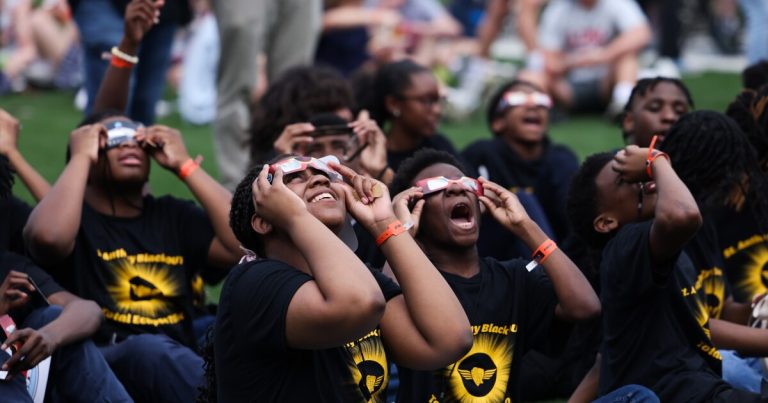Late afternoon clouds threatened to ruin Monday’s total solar eclipse, but by the time the eclipse was visible, Texas was the place to be.
An estimated 12,000 people gathered at the Cotton Bowl on Monday to watch the eclipse as part of an event organized by the National Oceanic and Atmospheric Administration, including Robbie Gorman and Tabitha Love, who are originally from England but now live in New York.
“Tabitha cried for about four minutes,” Gorman said.
“It was really emotional,” Love said with a laugh. “Especially when the sun came back, I was like, ‘It’s back!’ I didn’t realize how lonely it would be.”
For the hundreds of thousands of people who have traveled to the area from outside the city, the experience has been an emotional one. Dominic Chemero and his wife, Dawn, both 81, decided to drive to Fort Worth from Prescott, Arizona, on Sunday morning.
“It was spine-chilling,” Dominic Chemero said. “When the eclipse hadn’t even started, my wife and I were saying, ‘Do you think 18 hours of driving and three hours of sleep was really worth it?’ And I said, ‘Yeah,’ and then we saw the eclipse. Oh my goodness. What a reward.”

Millions of Texans live in the path of the eclipse, making North and Central Texas one of the areas with the longest total eclipse durations in the U.S. Dallas was the largest city where the eclipse was completely visible.
The Texas Department of Transportation estimates that up to one million travelers could pass through Texas in the storm’s path.
That’s why Connecticut resident Patsy Pedicini came to Dallas from East Haven on Monday.
“I wanted to be here because the center of the total solar eclipse is going to pass through downtown Dallas,” he said, standing in Dealey Plaza.
Pedicini, the owner of a novelty company that sells special equipment for events such as the Super Bowl and the World Series, drove 30 hours to Dallas last week and set up shop around downtown to sell eclipse-related merchandise.
He said he had been planning for the eclipse for more than a year.

Torwani Osibamowo
/
Kera
“Everybody wants a piece of what’s going on, a memory,” he said. “They want to take something home with them so they can tell their families, ‘Hey, I was there,’ or ‘We were there,’ and this is going to be a memory that everybody will remember for the rest of their lives.”
Dallas wasn’t the only North Texas city expected to see a boom in business.
The Fort Worth-Arlington-Grapevine area estimated that nearly $64 million in personal income was generated from eclipse-related business activity, Fort Worth Report previously reported.
About 200,000 people are expected to descend on Ennis, a city of 22,000 people about 40 minutes from the Dallas-Fort Worth area, just to watch the eclipse.
But on Monday, as clouds began to roll in over parts of Central and North Texas, tourists and locals alike were faced with an unexpected factor: weather. Cloudy weather had been forecast for both Central and North Texas on Monday ahead of the storm.

But for most of North Texas, the clouds briefly cleared around the time of the total solar eclipse.
At the University of North Texas in Frisco, outdoor telescopes were set up a few hours before the eclipse, and dozens of onlookers gathered, including Mark Wilson, 78, of Oak Cliff, who said gazing into the total eclipse was an awe-inspiring experience.
“I had this feeling that there was a hole in the fabric of the universe that I could go through, but I didn’t know what was on the other side,” he said. “It almost looked like a stargate. That’s what it looked like to me.”
Mark Crumpen, head of NASA’s astrophysics division, was visiting Texas on Monday to collect science data from Waco.
“This is an opportunity to get a very clear picture of the atmosphere around the sun,” he said.
NASA scientists are also looking at temperature changes and how that affects the atmosphere, even on cloudy days like Monday, and Krampen said the agency will also use data collected from citizen scientists who can record temperature changes and submit photos.

Torwani Osibamowo
/
Kera
About 12,300 people registered for a NASA-sponsored solar eclipse event at Dallas’ Cotton Bowl Stadium, and judging by the packed crowds, most of them showed up Monday, including Salt Lake City resident Angelica Meyer.
This was Meyer’s first time visiting Texas, and she said she made the spontaneous trip to Dallas because it was a once-in-a-lifetime experience she didn’t want to miss.
After researching NASA events, she got tickets to the Cotton Bowl to watch the solar eclipse with thousands of others, a moment she’ll cherish forever.
“It’s a shared experience, whether you know these people or not, and it’s something that will be shared forever,” she said. “To be able to say that I was there, and to be able to share that with others in the future, I think that’s really special.”
KERA News reporter Toluwani Osibamowo, Denton Record-Chronicle reporter Brooke Colombo, Fort Worth Report’s Emily Wolf and Marjorie Welch Fitz Lewis Fellow Zara Amaechi contributed to this report.
Have a tip? Email Megan Cardona Email:.
KERA News is made possible by the generosity of our members. If you find this report useful, Make a tax-deductible gift today. thank you!

